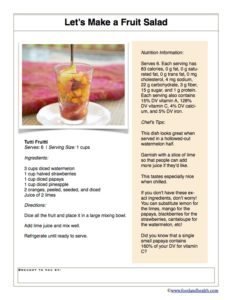Papaya Month Cooking Demonstration
Want to throw a fantastic Papaya Month cooking demonstration? Here's everything you need to know...Preparation is Key!How well you prepare for your cooking demonstration directly influences how well it will go. Here are some key things to keep in mind!
- Do your due diligence: Check in with the location. What equipment is available? Will you have/need a mic? If so, does it have fresh batteries?Are you familiar with the recipe? Are there any surprises? (This recipe is very straightforward, but just in case).Also, how many participants will attend your demonstration? Do you need to scale your recipe accordingly?
- Gather your equipment: For this demonstration, all you'll need is a measuring cup, a large bowl, a knife, and a cutting board. Make sure your knife is sharp and your cutting board is clean and sturdy. Alternatively, you could slice and measure the fruit beforehand and package it in sealable containers to bring to the demonstration -- just make sure to keep it cold! You can also bring sample cups and spoons if you're going to let your participants taste what you've made.
- Prepare your ingredients: Watching people chop and measure is hardly a recipe for a fascinating cooking demonstration, which is why I recommend slicing and measuring the fruit beforehand and bringing it, prepared, to your cooking demonstration. If you are using this demo to teach knife skills as well as the recipe, however, then it's best to slice your fruit on site. If you're taking this option, make sure the fruit is washed, dried, and otherwise ready for the demo. Either way, set up your ingredients in a food safe manner and make sure they're ready for your presentation. You don't want to be running around searching for oranges that you forgot to pack when you should be starting your demonstration.
During the Demo, Engage Your Audience!
- Ask questions: As you arrive and are setting up, if your audience is already present, ask them questions and get to know them a bit. Why are they here? What cooking experience do they have? What do they hope to learn today?
- Give your demonstration: If you're prepping the food for the audience, do that first. Then combine all the fruit into a large mixing bowl, squeeze 2 limes over it, and mix well. Offer fun facts about the ingredients and cooking tips as you go.
- Explore the finished product: Once you've finished the recipe, show everyone what it looks like (serving it in a clear glass bowl is great for this). Divide the fruit salad into sample cups and pass them around for tasting and discussion.
Every demo is better with a printable recipe handout, so here's the recipe we've been discussing in today's demo tips. If you're doing this demonstration, it might be nice to print some copies and distribute them to your audience, or you can include the PDF as an attachment to the follow up email. To finish off this post, don't miss these wonderful cooking demonstration resources![shopify embed_type="product" shop="nutrition-education-store.myshopify.com" product_handle="cooking-demo-ideas-book-and-cd" show="all"][shopify embed_type="product" shop="nutrition-education-store.myshopify.com" product_handle="cooking-demo-kit-set-of-10-cooking-tools" show="all"][shopify embed_type="product" shop="nutrition-education-store.myshopify.com" product_handle="myplate-cooking-demo-ideas-book" show="all"]
To finish off this post, don't miss these wonderful cooking demonstration resources![shopify embed_type="product" shop="nutrition-education-store.myshopify.com" product_handle="cooking-demo-ideas-book-and-cd" show="all"][shopify embed_type="product" shop="nutrition-education-store.myshopify.com" product_handle="cooking-demo-kit-set-of-10-cooking-tools" show="all"][shopify embed_type="product" shop="nutrition-education-store.myshopify.com" product_handle="myplate-cooking-demo-ideas-book" show="all"]
